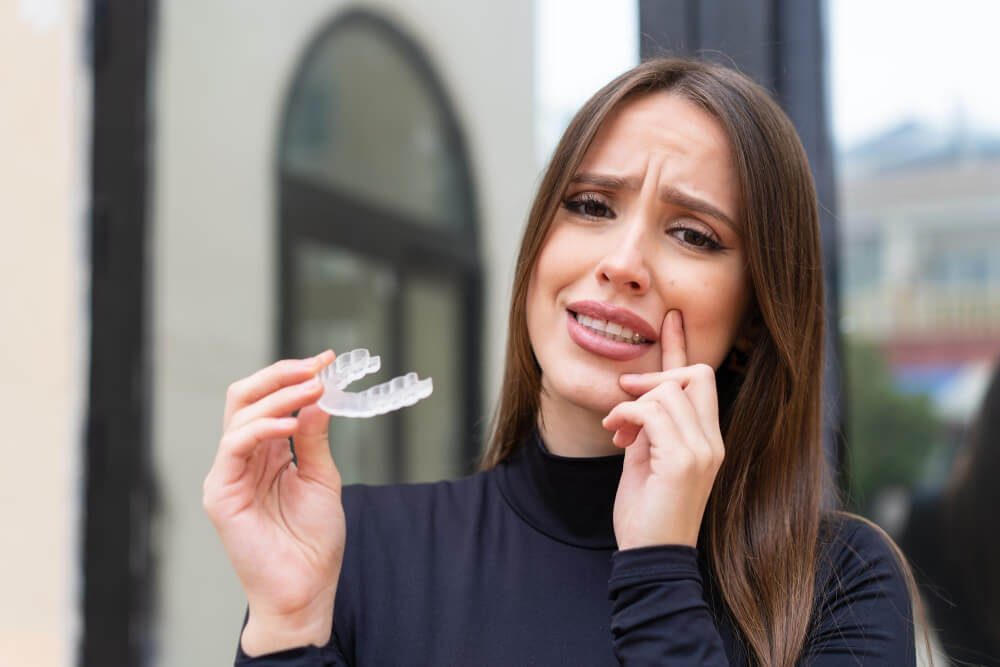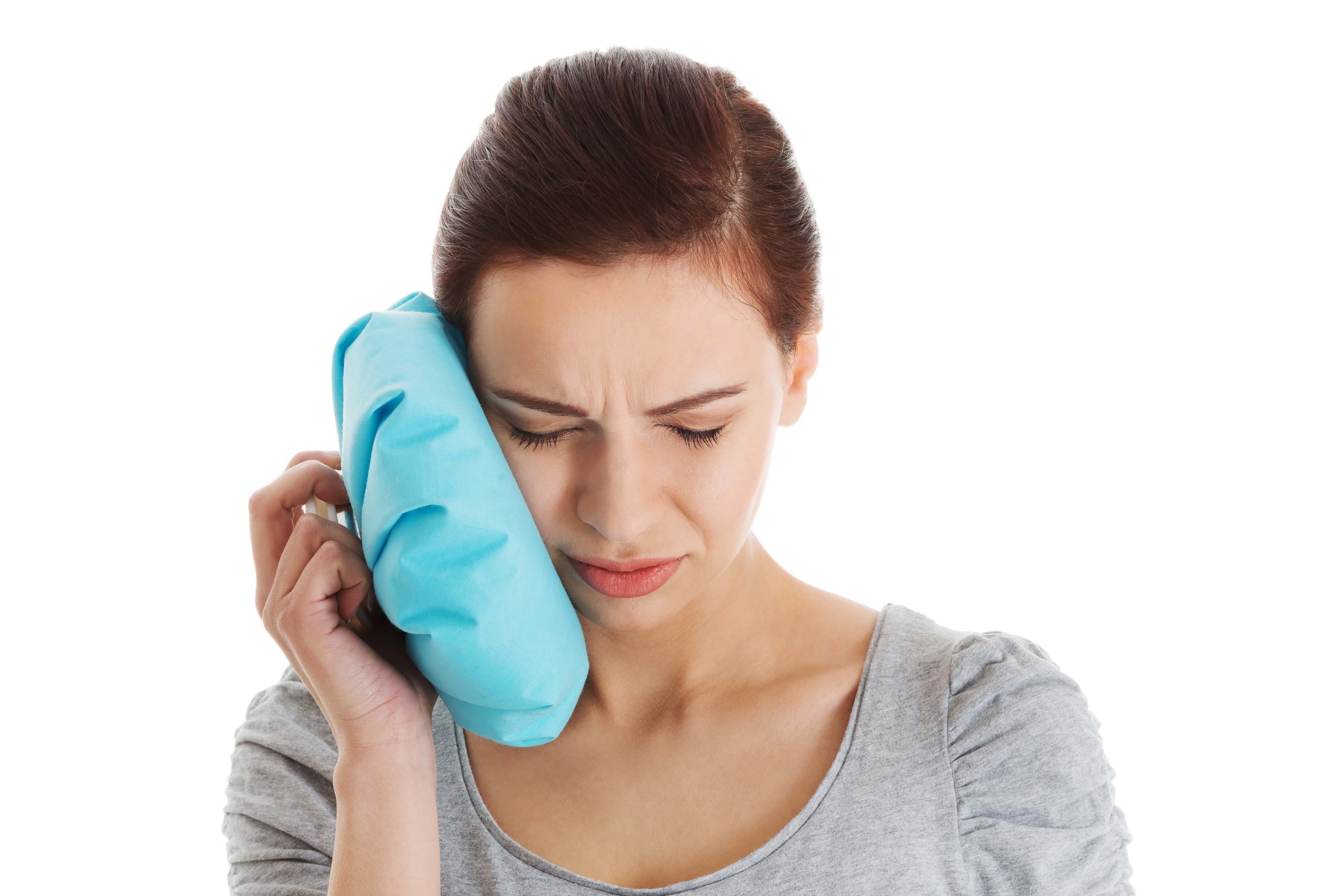Invisalign Pain Relief: Remedies for Discomfort

Invisalign is an excellent choice for straightening teeth, yet it may cause discomfort, pain, or soreness. Generally speaking, the ache associated with Invisalign is milder than that of traditional braces and can be felt differently from person to person.
Most patients describe the feeling as a pressure-like sensation when their teeth shift into place in new positions. When undergoing Invisalign treatment, the most frequent moments of discomfort come at the start and when transitioning to a new aligner tray.
This is because your teeth are being moved into an unfamiliar position that may cause distress. With each new aligner, another step in this repositioning process is taken.
At the same time, some individuals only experience pain for a few days, and others may have ongoing soreness throughout their entire treatment period.
Whether through lifestyle changes or medicine, don’t hesitate to take steps toward Invisalign pain relief and ease the soreness caused by realigning your teeth. But before that, let’s first go through the causes of pain from Invisalign.
Common Causes of Pain from Invisalign
1. Unfamiliar sensation
As you begin using Invisalign, your teeth and mouth may feel uncomfortable adjusting to the aligners and may experience novel sensations.
2. Irritation from aligners
For some, the alignment trays may result in irritation or soreness of the cheeks and gum lines due to contact with plastic materials.
3. Pressure (the leading cause of Invisalign jaw pain)
Invisalign treatment relies on pressure to guide teeth into the desired position; however, this force can cause soreness and aches in the beginning stages.
Therefore, starting with a comfortable amount of pressure is essential while being mindful of any discomfort you may experience along your orthodontic journey.
4. Chewing on aligners
Remember never to chew on your Invisalign trays, as their sharp edges can cause immense pain and discomfort to the inside lining and the gums in your mouth.
5. Increased cavities/Tooth degradation
Proper oral hygiene, such as brushing and flossing regularly, is essential when undergoing orthodontic treatment.
This will help reduce the risk of cavities, especially around brackets or aligners, which can accumulate plaque in hard-to-reach areas if not kept clean.
6. Jaw pain
Often, incorrect alignment between the upper and lower jaw can lead to jaw pain caused by grinding or improper bite closure.
Regular follow-up appointments with your Northbridge dentist are necessary when dealing with Invisalign treatments, as they can spot misalignment issues early before they cause too much discomfort.
7. Speech impediment
While adjusting to speaking while wearing an aligner, you may start lisping completely unconsciously until you get used to how it feels in your mouth; this could make conversations awkward.
Taking a small break from wearing your device for conversations may help ease this problem until you eventually get accustomed, but speech impediment is still expected for some individuals using aligners for two weeks or more than 20 hours per day.
8. Dry mouth syndrome
Salivary glands may produce less saliva when an individual wears an aligner, leading them prone to having dry mouth syndrome, which, other than being uncomfortable, also makes it easier for bacteria or debris from food or drinks to be removed via brushing after meals; this then leads cavitation due lack of a proper cleaning process as well as bad breath (halitosis) over long periods which could eventually damage teeth further if not cared for appropriately using a remineralising rinse when possible.
9. Difficulty eating certain foods/drinks
Wearing a specific type of object inside your mouth, including a plastic material-based retainer, might restrict certain foods, such as chewy textures like taffy candies or crunchy snacks like chips; those were found harder than usual for individuals wearing aligners, although one could eat these types of food occasionally just given particular precautions have been taken (such as removing aligner beforehand) after consulting with their doctor prior processing further with treatment.
10. Pain reliever dependency
During the initial phase, patients might feel inclined to take over-the-counter pain medicines more often than usually advised, dependingon each individual’s level of discomfort resulting from such new conditions as having something foreign inside their mouths while attempting adjustments to correct dentition shapes.
Home Remedies for Pain from Invisalign?
If you’re searching for effective Invisalign pain relief, these at-home strategies can help minimise discomfort and support a more comfortable treatment experience.
Use an icepack or cold compress for Invisalign pain.
To reduce swelling and provide temporary relief from pain, place something cold against your skin. A classic ice pack or frozen veggies in a Ziploc bag make strong candidates for this task; you can also opt for a cold compress if desired.
Make sure that whatever item you choose is always wrapped in a cloth or towel to prevent direct contact with the affected area. You may repeat this technique several times throughout the day as needed – never any longer than 10 minutes at once
Drink cold water
If you’re looking for a fast, effortless way to reduce the pain of your aligners, try sipping on some chilled water. This is an easy solution that can be done without taking out your aligners.
Plus, it’s good for you. Unlike other sugary drinks like juice or soda, cold water won’t cause cavities or damage your teeth in any way.
Suck on ice cubes
To reduce the effects of Invisalign discomfort, sucking on ice cubes can be a lifesaver. There is no need to take out your aligners beforehand; remember to suck, not chew.
Chewing down too hard may lead to even more pain, as teeth become sensitive while wearing Invisalign. This quick and easy action will help ease mild discomfort quickly.
Avoid eating hard food.
If your teeth are aching, avoid crunchy foods such as nuts or crackers, as they can be intensely painful to chomp down on.
Instead, opt for softer edibles like bread, hummus, tuna salad, and hard-boiled ggs, which will not cause further suffering.
Use over-the-counter painkillers
Ibuprofen, aspirin, and acetaminophen are popular over-the-counter painkillers that can alleviate Invisalign discomfort. Always follow the medicine’s dosage and directions as indicated on its packaging.
If you often struggle with Invisalign pain after switching aligners, a preemptive dose of an OTC analgesic might help minimise or prevent any subsequent suffering.
Make sure your Invisalign is seated correctly.
Ensure that your aligners are completely seated and pressed into place when inserting. If they’re not fitted adequately against your teeth, they may become uncomfortable due to the unnecessary pressure.
Moreover, improperly seated alignment can cause even more pain by pulling teeth into an incorrect position.
Don’t take your aligners out too often.
It should be worn for no less than 22 hours daily for optimal Invisalign results. It is only necessary to remove them when consuming food and drinks or brushing your teeth.
Some customers have even claimed they experienced reduced discomfort by wearing their aligners for longer.
However, if you accidentally forget to put them back in after eating or drinking something and then slip the aligners on later, you may feel your Invisalign hurt due to your teeth shifting—this can lead to pain until your mouth adjusts again with the help of these clear braces.
Start new aligners before bed to avoid Invisalign pain.
To help reduce gum pain, insert your new aligners a few hours before bedtime. This gives your teeth time to adjust while you slumber and prevents the extra hassle of taking them out when it’s time for meals.
By sleeping through the initial adjustment period, you can ease into wearing them without much pain or discomfort.
Stay on schedule
Follow the individualised plan tailored to your needs to ensure maximum comfort and expedited straightening results. Don’t be tempted to accelerate your Invisalign journey by changing aligners before it’s time; this could cause more discomfort than necessary.
Rinse your mouth with salt water.
Do you experience mouth sores with Invisalign? If so, saltwater can be used to clean the affected area. Merely swish it around your mouth and then spit it out for Invisalign pain relief.
Be patient
Initially, many people using Invisalign aligners will feel gum or tooth pain. But as your teeth begin to get accustomed to the clear aligners and shifting, you’ll observe a decrease in discomfort.
Though it may be tempting to give up right away due to this initial soreness, if you endure it for several months, then your pain should have diminished completely or become significantly reduced.
Invisalign Pain Relief in Northbridge
Are you in need of Invisalign pain relief? Our compassionate dentists at My Local Dentists are ready to assist.
We’ll investigate what’s causing your pain and provide a cost-effective solution so that you can feel better quickly. Let us take care of your dental health.
Call your Northbridge dentist at (02) 8318 5966.
Visit us at Shop 20a, Northbridge Plaza, 79-113 Sailors Bay Road in Northbridge.
